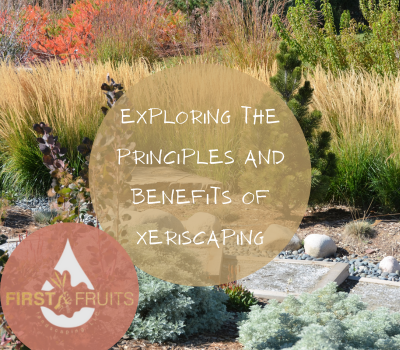In a world where water scarcity is becoming an increasingly pressing issue, finding ways to conserve water has never been more important. One area where water conservation can have a significant impact is landscaping. Traditional lawns and gardens require substantial amounts of water to maintain their lush appearance, often leading to wastage and strain on local water resources. This is where xeriscaping, or xeriscaping, comes into play – a landscaping technique that focuses on creating beautiful and sustainable outdoor spaces while minimizing water consumption.
Drought-Resistant Landscaping: Exploring the Principles and Benefits of Xeriscaping
What is Xeriscaping?
Xeriscaping is a landscaping philosophy that originated in arid regions where water is scarce. The term “xeriscape” is derived from the Greek word “xeros,” meaning dry, and “landscape.” However, don’t mistake xeriscaping for a barren desert-like yard. Instead, it’s a thoughtful approach to landscaping that combines water-efficient design, appropriate plant selection, and efficient irrigation practices to create visually appealing and sustainable outdoor spaces.
The Principles of Xeriscaping
1. Water-Efficient Design:
Xeriscaping begins with a well-thought-out design that considers the natural water flow and topography of the land. By strategically placing plants based on their water needs and grouping them according to their moisture requirements, water can be distributed more effectively.
2. Appropriate Plant Selection:
One of the key principles of xeriscaping is choosing plants that are well-suited to the local climate and soil conditions. Native plants are often the best choice, as they have evolved to thrive in the local environment and require minimal additional water once established.
3. Soil Improvement:
Healthy soil retains moisture better, reducing the need for frequent irrigation. Adding organic matter, such as compost, to the soil improves its structure, water-holding capacity, and nutrient content.
4. Mulching:
Applying mulch around plants helps to keep the soil cool, suppress weed growth, and reduce water evaporation. Organic mulches, like wood chips or straw, also break down over time, enriching the soil.
5. Efficient Irrigation:
Xeriscaping promotes water-efficient irrigation methods, such as drip irrigation or soaker hoses. These systems deliver water directly to the root zone, minimizing evaporation and runoff.
6. Limiting Turf Areas:
Traditional lawns are notorious for their high water demands. In xeriscaping, turf areas are minimized and strategically placed, usually in high-traffic or functional zones.
7. Practical Lawn Alternatives:
Where grass isn’t necessary, xeriscaping encourages the use of ground covers, gravel, or hardscaping materials like stone paths and patios. These alternatives not only save water but also add texture and interest to the landscape.
The Benefits of Xeriscaping
1. Water Conservation:
The most obvious benefit of xeriscaping is the substantial reduction in water consumption. Xeriscaped yards can use up to 50-75% less water than traditional lawns, making it a vital technique for areas prone to drought.
2. Lower Maintenance:
Traditional lawns require frequent mowing, watering, and fertilizing to maintain their appearance. Xeriscaped landscapes, on the other hand, require significantly less maintenance, freeing up time and resources for other activities.
3. Cost Savings:
With reduced water usage and lower maintenance requirements, xeriscaping can lead to substantial cost savings over time. Water bills, lawn care equipment, and fertilizers become less of a financial burden.
4. Increased Property Value:
A well-designed xeriscaped yard adds curb appeal and can increase property value. Potential buyers are often drawn to landscapes that are not only visually appealing but also environmentally conscious.
5. Biodiversity and Wildlife Habitat:
Native plants used in xeriscaping provide habitat and food sources for local wildlife, including birds, butterflies, and pollinators. This contributes to the overall health of the ecosystem.
6. Resilience to Climate Conditions:
Xeriscaped yards are more resilient to changing climate conditions, including droughts and water restrictions. The water-wise design and plant selection can help your landscape thrive even during challenging times.
7. Personal Satisfaction:
Creating a xeriscaped yard is a rewarding endeavor. Witnessing the beauty and diversity of plants that are adapted to your region’s natural conditions can provide a sense of pride and connection to your surroundings.
Getting Started with Xeriscaping
If you’re interested in implementing xeriscaping principles in your yard, here are a few steps to get started:
1. Assess Your Yard:
Evaluate your yard’s soil type, sun exposure, and existing vegetation. Identify areas that can be transformed into more water-efficient landscapes.
2. Choose Native Plants:
Research native plants that thrive in your region’s climate and soil conditions. These plants are naturally adapted to the local environment and require less water.
3. Plan Your Design:
Create a design that considers the placement of plants, hardscaping features, and turf areas. Focus on grouping plants with similar water needs together.
4. Improve Soil Health:
Prepare the soil by adding compost and other organic matter to improve its structure and water retention capabilities.
5. Install Efficient Irrigation:
Consider installing drip irrigation or soaker hoses to deliver water directly to plant roots. This minimizes water wastage and encourages deep-root growth.
6. Mulch and Maintain:
Apply a layer of organic mulch around plants to retain moisture and suppress weeds. Regular maintenance, including pruning and occasional watering during establishment, is still important.
7. Be Patient:
Xeriscaping is a long-term investment. It might take a season or two for plants to establish themselves fully, but the results will be well worth the wait.
In Conclusion
In a world where water resources are increasingly strained, xeriscaping offers a practical and aesthetically pleasing solution to maintaining attractive landscapes without excessive water use. By embracing the principles of water-efficient design, appropriate plant selection, and sustainable practices, homeowners can contribute to water conservation efforts while enjoying the beauty of their outdoor spaces. Whether you’re living in an arid climate or simply want to be a responsible steward of the environment, xeriscaping is a sustainable landscaping choice that benefits both you and the planet.
If you need help with landscaping design or maintenance, contact us. Our team provides information and solutions to meet your property’s needs effectively. Don’t hesitate to reach out – we’re here to assist you!

